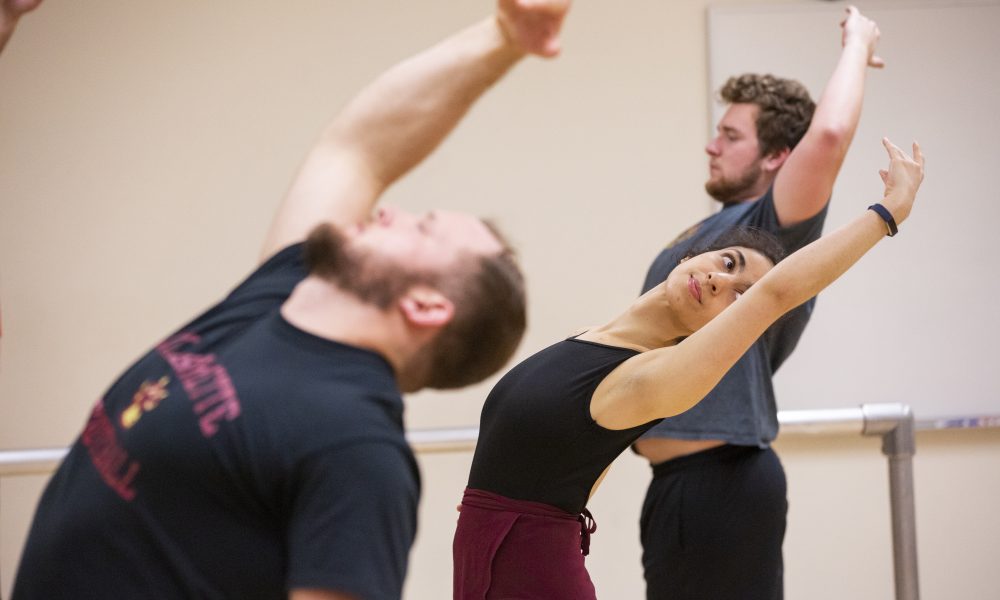
Monya Maleki leads a ballet class for Willamette University football players. (Frank Miller/Courtesy of Willamette University)
Monya Maleki wasn’t sure what to expect when she agreed to teach ballet to Willamette University football players.
But she found her first group of athletes eager to learn.
“They just jumped right in. There was no fear, they went for it. There was no shame,” she said.
Maleki, a 2019 Willamette graduate in exercise and health science, will begin weekly classes for the entire Bearcat team in the fall after research her senior year showed the practice can improve flexibility and agility for athletes.
It’s an unusual form of cross-training that new head coach Isaac Parker has embraced.
Many football teams use lighter activities like yoga or swimming to aid recovery after a game and build flexibility.
Maleki’s project’s appealed to Parker because of the focus on core strength and the way ballet works small muscles and tendons in the feet and ankles, which can be difficult to target during practice.
“A lot of times the worst injuries are the little things like that,” he said.
Maleki’s research started last fall in an exercise physiology class with Michael Lockard, an associate professor of health and exercise science.
As a student athletic trainer, Maleki frequently saw athletes with little flexibility being treated for injuries.
“Often I find that the athletes had limited range of motion,” she said. A dancer since she was three, Maleki thought ballet could help improve flexibility and prevent injury but found there was little to no research on the concept.
She set out to do her own research, starting with a volunteer group of 10 football players.
Maleki expected they might underestimate the athleticism and physical skill required for dance. She was pleasantly surprised.
“After the first class I could tell they had an appreciation for the sport,” she said. “I think I stereotyped football players more than they stereotyped dancers.”
Her work showed the players who took three 30-minutes ballet classes per week for two weeks were about two seconds faster on an agility test than a control group of players. They also improved range of motion in the shoulders.
Maleki presented the findings at a regional sports medicine conference and conducted a larger study in the spring, which showed similar results.

A Willamette University football player practices ballet. (Frank Miller/Courtesy of Willamette University)
She’s often asked why athletes should consider ballet rather than yoga or Pilates to train flexibility. Maleki said the dynamic motion of dance makes it a better proxy for football and does a better job training agility.
“It requires so much strength and control and awareness of how your body is going to move in space,” she said. “You have to be able to balance and protect your body constantly in many different ways.”
Lockard said a handful of students in his class each year go on to present research findings regionally, and about 2% publish their results. Maleki’s is the first to turn into a larger research project, which he attributed to the mix of her expertise and enthusiasm.
“I was never surprised when it seemed like every other day she was at my office door really excited about the latest thing that went really well,” Lockard said.
Parker was hired as Willamette’s football coach last December, after Maleki’s initial study. He didn’t drop in on her spring ballet classes for players because he didn’t want to interfere with the results but sees ballet as a way to encourage a positive culture on the team.
“If I can get a 20-year-old to do ballet with a straight face and not flinch,” he said, that’s “teaching a healthy masculinity.”
As a native Hawaiian, dance was part of Parker’s schooling. He danced hula with classmates and sees the art as an important part of every culture.
“Any type of performance art always seems to have a twofold of sharing something while also embracing an individual journal or a challenge,” he said. “For me, that’s not a lot different than football.”
And a student who can get outside his comfort zone performing ballet on stage in front of friends is one who’s going to perform better under pressure in a football game, Parker said.
Maleki’s spring class turned up with enthusiasm.
“Before even knowing what it would be like, one of the guys yelled out ‘So when’s our performance?’” she said.
They performed in a spring show. Ten men in black shorts took turns leaping gracefully over a teammate and pliéd and pirouetted around the stage to a medley of classical music as an audience cheered raucously.
Parker said some football players who didn’t take ballet classes brought the young men flowers.
Maleki is now working at a physical therapist office in Tacoma and will commute to Salem on Sundays by train to teach the fall class to the full 75-person team.
Parker said he’s eager to see the results.
“I’m hoping it stays,” he said.
Have a tip? Reporter Rachel Alexander: [email protected] or 503-575-1241.
LOCAL NEWS AND A LOCAL SUBSCRIPTION — For $10 a month, Salem Reporter provides breaking news alerts, emailed newsletters and around-the-clock access to our stories. We depend on subscribers to pay for in-depth, accurate news. Help us grow and get better by subscribing today. Sign up HERE.

Rachel Alexander is Salem Reporter’s managing editor. She joined Salem Reporter when it was founded in 2018 and covers city news, education, nonprofits and a little bit of everything else. She’s been a journalist in Oregon and Washington for a decade. Outside of work, she’s a skater and board member with Salem’s Cherry City Roller Derby and can often be found with her nose buried in a book.









